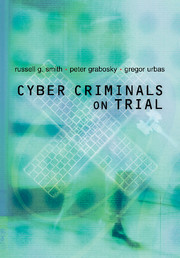Book contents
- Frontmatter
- Contents
- List of figures and tables
- Acknowledgments
- Preface
- Abbreviations
- Currency exchange rates
- Chapter One Introduction
- Chapter Two Defining and Measuring Cyber Crime
- Chapter Three The Prosecutor as Gatekeeper
- Chapter Four Cross-Border Issues
- Chapter Five Strategies of Cyber Crime Litigation
- Chapter Six The Quest for Harmonisation of Cyber Crime Laws
- Chapter Seven Judicial Punishment in Cyberspace
- Chapter Eight Sentencing Cyber Criminals
- Chapter Nine Conclusions
- References
- Appendix A Case Summaries 1972–2003
- Appendix B Selected Legislative Summaries
- Index
Chapter Eight - Sentencing Cyber Criminals
Published online by Cambridge University Press: 22 September 2009
- Frontmatter
- Contents
- List of figures and tables
- Acknowledgments
- Preface
- Abbreviations
- Currency exchange rates
- Chapter One Introduction
- Chapter Two Defining and Measuring Cyber Crime
- Chapter Three The Prosecutor as Gatekeeper
- Chapter Four Cross-Border Issues
- Chapter Five Strategies of Cyber Crime Litigation
- Chapter Six The Quest for Harmonisation of Cyber Crime Laws
- Chapter Seven Judicial Punishment in Cyberspace
- Chapter Eight Sentencing Cyber Criminals
- Chapter Nine Conclusions
- References
- Appendix A Case Summaries 1972–2003
- Appendix B Selected Legislative Summaries
- Index
Summary
Introduction
Having examined the purposes of judicial punishment as applied in connection with cyber crime, and reviewed some of the sanctions that courts have used in recent decisions, we now consider the sentencing process itself and the extent to which certain punishments have been imposed. We also seek to find out the extent to which the presence of a computer in the commission of a crime affects the sentence imposed by the court. We shall do this by examining a small sample of cases decided in Australia and New Zealand involving serious fraud, some of which had computer involvement, and others of which did not.
In achieving the various aims of punishment, courts are required to take into account any aggravating factors (or what are known in the United States as ‘enhancements’ to the level of penalty applicable to the offence, as specified in the United States Sentencing Commission's Sentencing Guidelines (2003b)), in addition to mitigating factors raised on behalf of the defendant (or what are known in the United States as ‘downward departures’ from the Commission's Guideline sentences). This enables the court to adopt an individualised punishment adapted to the circumstances of the offender, while at the same time taking into consideration matters of more general import to the community as a whole, such as the need to demonstrate denunciation of the conduct in question and to achieve general deterrence.
- Type
- Chapter
- Information
- Cyber Criminals on Trial , pp. 124 - 149Publisher: Cambridge University PressPrint publication year: 2004



